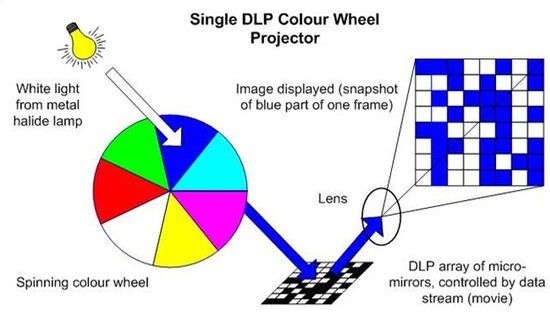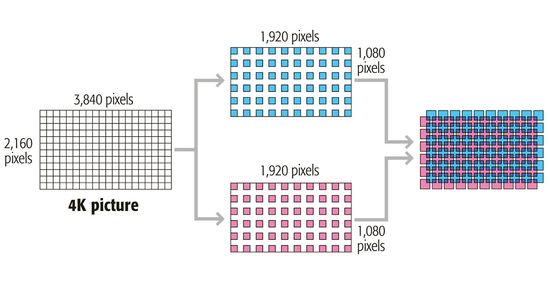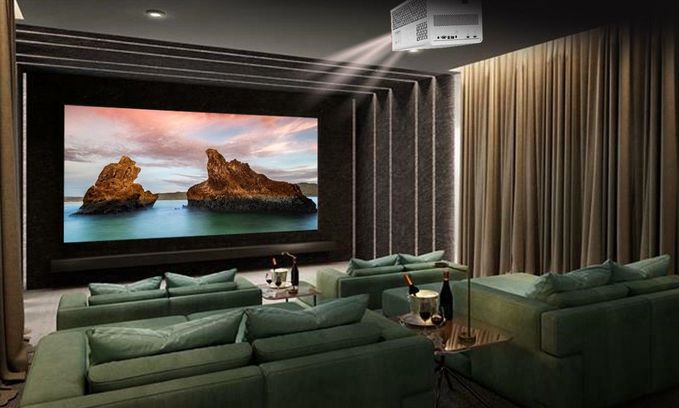As known, BenQ Corporation started out as a contract manufacturing arm of Taiwan’s Acer Computer Corporation. The company got its current name after splitting from Acer in 2001. It’s an acronym for ‘Bringing Enjoyment and Quality to Life’ (BenQ). Today BenQ is a Taiwanese multinational company that designs, manufactures and sells technology products, consumer electronics, etc. Its head office is located in Taipei (Taiwan), but the company also has branches in North and Latin America, Asia-Pacific, Europe, China, etc.
Despite a very wide range of products, including monitors, DVD+RW drives, color laser printers, scanners, wireless networking and communications equipment, etc, projectors have become one of its most successful businesses. Already by 2014, the share of sales of BenQ projectors in Europe exceeded 20%. Today, the company is positioned as one of the leading manufacturers of DLP projectors, offering from pocket LED models to premium home theater projectors. In accordance with its status, the company annually expands its lineup. 2022 was no exception, and the company introduced several new models, including the BenQ X3000i and BenQ LK936ST.
BenQ projectors 2022
LK936ST perfectly corresponds to the popularity growth trend of Ultra Short Throw (UST) projectors. The optics of these models provide close-to-screen placement, making them an ideal TV alternative without the hassle of running wires in the living room. Some sellers even call them ‘living room projectors’.

Already in 2022, this segment has significantly expanded due to:
– Hisense PX1-Pro and L5G Laser TVs – up to $ 4,000;
– LG HU715Q – $ 3,000;
– JMGO U2 – $ 3,000.
LK936ST 4K (3,840 x 2,160) model costs $ 4,500 (MSRP) and has great specs, including an impressive brightness of 5,100 ANSI Lumens and 3,000,000:1 dynamic contrast ratio. The excellent ratio of price and quality provides excellent marketing prospects for this projector.
The X3000i expands BenQ’s line of gaming projectors. In fact, it has become an improved version of last year’s popular X1300i. The new model is quite consistent with the wise proverb – ‘avoid attempting to correct, fix, or improve what is already sufficient’. With the exception of the new chipset and, accordingly, the prices, functionality and specs of the models are almost identical. The new 4K-capable DLP650TE chipset from Texas Instruments (TI) with four-phase pixel shifting and increased micromirror pitch from 5.4 µm to 7.6 µm is a significant advance.
In addition, according to the company, X3000i uses new CinematicColor technology with precise nanometer-level references for its color-wheel angles and coating, delivering 100% DCI-P3 vs 98% Rec.709 in the BenQ X1300i. Unfortunately, the price has also gone up from $ 1,300 to $ 2,000. However, the X1300i remains one of the cheapest 1080p gaming projectors, and the X3000i becomes the cheapest 4K gaming model.
DLP650TE chipset
In 1987 Texas Instruments announced Digital Micromirror Device (DMD). It was an array of tiny aluminum mirrors, the number of which reached several million. Rotating the micro mirror by a small angle switches the direction of the reflected light, each corresponding to the ‘On’ / ‘Off’ state.

A 2D array of 1-bit CMOS memory cells under the mirrors controls mirrors tilt. The light is directed to the micromirror and, depending on its state, is blocked or re-reflected through the lens to the screen, forming subpixels.

Accordingly, the number of micromirrors determines the resolution of the image, and their size determines the light output, which, in turn, affects the noise. But, of course, increasing the size requires reducing their number.
In search of an optimal compromise, JVC developed and introduced in 2013 an elegant pixel shifting technology for its D-ILA chipset. The projector creates an additional image and shifts it vertically and horizontally by half a pixel. As a result, our eye sees more pixels and perceives the image more clearly.

A few years later, Epson developed a pixel shift version for their (1,920 x 1,080) 3LCD chips, and Texas Instruments introduced an .66″ chip (2,716 x 1,528) with two-phase pixel shifting, increasing their number on the screen to 4.15 M at micromirror pitch of 5.4 µm. In 2017, the .47″ DLP 4K UHD chipset with similar micromirror pitch became the next generation. At a resolution of (1,920 x 1,080), it uses four-phase pixel shifting, increasing the number of pixels by a factor of 4 (8,3M). Finally, last year TI introduced the latest 4K DLP650TE chipset, which combines four-phase pixel shifting and increasing the micromirror pitch from 5.4 µm to 7.6 µm.
DLP XPR technology
The four-phase pixel shifting uses XPR module, which includes the optical and the electromechanical part. The specially processed glass of optical unit divides the light beam along the horizontal and vertical axes. The electromechanical part is placed in front of the lens.

This component is four electromagnets that move a lens in the vertical and in the horizontal axis. In fact, the XPR module increases the chipset operating frequency. Physically, it shifts the image on the screen by turning the lens 4 times per second.

As a result, XPR increases the frequency by 4 times to 240 fps. Simply put, this technology takes 4K content, splits it into four parts of 2 million pixels each, and plays 4 separate frames 240 times per second (60Hz х 4), transmitting the entire 4K volume with the help of only 2 million pixels. Strictly speaking, at any given moment, the image contains only 2 million pixels (1080p resolution), which are shifted on the screen using a lens controlled by electromagnets. At the same time, our vision and brain do not perceive the micro-delay between their switching, creating the illusion of a holistic image.
Of course, the precision XPR module adds to the projector’s price, but it’s negligible compared to the quality gains due to the resolution increase from 1080p to 4K UHD (2160p).

In fact, this technology has allowed developers to create a 4K-capable BenQ X3000i with a new .65″ DLP650TE chipset priced at $ 2,000. It could well be positioned as a new generation of inexpensive 4K-capable DLP projectors.
BenQ X3000i vs BenQ X1300i
Other specs of the models are identical:
– 3,000 ANSI Lm brightness;
– 4LED light source;
– Dynamic Contrast 500,000:1;
– Input Lag 4K@60 – 16ms; 1080p@120 – 8ms; 1080p@240 – 4ms;
– 3D Modes – Full HD 3D;
– Throw Distance / Image Size / Throw Ratio – (1.0 m – 8.0 m) / (77 cm – 762 cm) / (1.15:1 – 1.50:1), 100″@9.4ft;

– Digital Keystone – Horizontal & Vertical (±30°);
– Audible Noise – 32 dB;
– Internal Speakers – 5.0 Watts × 2;
– Color Processing 10-bit.
As known, brightness loss on the color wheel during filtering the colors is one of the main problems of the DLP projectors. To solve this problem, BenQ used 4LED (RGBB) light source in these projectors. The light output of an additional blue ‘pumping’ LED is converted by a ceramic phosphor into green, the brightness of which is best perceived by our eyesight.

According to the company, it increases the green output light by 40%, providing an increase in overall brightness of about 8-12%.
Additionally, both models have auto-calibration which adjusts the color intensity depending on the LEDs deterioration (usually, red deterioration faster).
A short list of minor differences include (BenQ X3000i vs BenQ X1300i):
– Color Wheel – 8 segment (RGBWRGBW) vs 6 segments;
– Included Lens – 1.3x manual zoom vs 1.2x manual zoom;
– 100%DCI-P3 (‘CinematicColor’) vs 98% Rec.709.
‘CinematicColor’ in BenQ X3000i uses precise nanometer-level references for its color-wheel angles and coating.
Game Mode
The company positions the X1300i/X3000i as ‘console gaming projectors’. In fact, BenQ gaming series combines the unprecedented low Input Lag and GameMaestro technology. A funny chart from BenQ perfectly illustrates the conditional classification given this criterion.

Gaming mode reduces Input Lag up to:
– 4K@60Hz – 16.67 ms (X3000i);
– 1080p@60Hz – 16.67 ms;
– 1080p@120Hz – 8.33 ms;
– 1080p@240Hz – 4.16 ms (X3000i).
This is one of the best indicators in the industry.
In fact, GameMaestro offers a three submodes with different color and grayscale calibration, including FPS, RPG and SPG. Switching modes is carried out using the button on the control. This option is available from Gaming Menu (HDR Game or HDR 10) or Entertainment Menu (Bright, Living Room, Sports, Game, Cinema and User modes).
According to BenQ:
– FPS (First-person shooter) – ‘Marks Nearby Threats’ (it enhances detail).

– RPG (Role-Playing Game) – ‘Full Cinematic Immersion’. It has very accurate color and more balanced audio profile, providing cinematic color, which corresponds to the Cinema preset, and film-like sound with enhanced bass.

– SPG (sport) – ‘For Real-Time Thrills’. It provides more vibrant greens and puts the focus on dialogue, which is important, for example, for sports announcers.
Moreover, the option offers customizable audiovisual equalization presets.
Multi-source audio tuned via treVolo and Bongiovi Digital Power Station (DPS) enhances soundtracks and music. Using an algorithm based on 120 calibration points, DPS optimizes the audio signal. According to the developer, it adds ‘depth, clarity, definition, presence, and enhanced stereo field imaging in real time’. In fairness, the sound is really great for this class. In addition, Dynamic Stereo Enhancement option in DPS generates reactive surround sound for different scenarios.
Input lag vs response time
These concepts are sometimes confused. Input lag (or latency) of projector is the time between receiving a signal, for example, from a game console, and the moment of image projection formation. In fact, this is the signal processing time. Response time in gaming corresponds to the duration of time between the command at the moment the button was pressed and its execution in the game. It depends on the game settings and the performance of all hardware components. Therefore, the response time is always significantly greater than the Input lag. But turning off all advanced image processing features such as keystoning, aspect ratio manipulations and overscanning provides the fastest speed.
The score of a projector performance in games also depends on the refresh rate (or refresh frequency). Physically, it’s the rate at which the device projects frames onto the screen and is an analog to the frame rate for a projected video. But frame rate is measured in frames per second (fps), and refresh rate uses hertz (Hz). Wherein, a projector with a 120Hz refresh rate projects 120 frames every second. Of course, it directly affects the image quality, especially in fast scenes in the games. High refresh rate provides cleaner, smoother motion and less blur.

Some sellers sometimes list 4K@240Hz support in projector specs. But, unfortunately, the current models do not support it. The hardware of modern projectors is only able to reach a 240Hz refresh rate when the resolution is reduced up to 1080p (Full HD). Moreover, today gaming console manufacturers do not offer models that support 240Hz content output. Therefore, a projector with a refresh rate of 240Hz for gaming purposes can be considered an investment in the future.
Conclusion
Pros
– great price;
– 3,000 ANSI Lm brightness with new 4LED light source;
– dynamic contrast 500,000:1;
– unprecedentedly low input lag;
– great color accuracy in Cinema mode;
– treVolo stereo speakers with Bongiovi DPS technology;
-GameMaestro technology;
– auto color calibration;
– great Full HD 3D;
– 100% DCI-P3 with WCG setting (BenQ X3000i, CinematicColor);
– new 4K-capable DLP650TE chipset (BenQ X3000i);
– 240Hz support (BenQ X3000i).
Cons
– not perfect black level;
– no Netflix;
– rainbow effect in some scenes;
– no motion smoothing;
– built-in speakers 10W only;
– no HDMI 2.1 and 4K@120.
Today, BenQ provide the best value for money in the gaming projector segment. Indeed, $ 1,300 and $ 2,000 for 1080p and 4K UHD models with great brightness, contrast, unprecedentedly low input lag and a range of exclusive features from one of the industry leaders are very inexpensive.
Of course, comparing these models with each other is not very correct, because they belong to different classes. $700 is a significant difference, but it’s quite consistent with the difference in image quality of 4K vs 1080p.
Anyway, the X1300i remains one of the cheapest 1080p gaming projectors, and the BenQ X3000i becomes the cheapest 4K gaming model.
This video shows the new gaming BenQ X3000i 4K LED projector.
